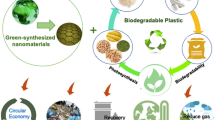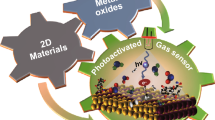Abstract
In the current study, polymer composite films (PCFs) of polyvinyl alcohol (PVA) and Dextrin (60/40) wt% without and with 0.03 and 0.06 wt% silicon dioxide nanoparticles (SiO2NPs) were synthesized via casting way. The structural properties of the matrix polymer blend (MPB) were investigated using X-ray diffraction and revealed an amorphous structure. However, some kind of crystallinity has appeared after embedding the SiO2NPs. The chemical functional groups were analyzed via FTIR spectra. The surface morphology characteristics were performed utilizing an optical microscope (OPM), and the images showed that SiO2NPs were well diffused in MPB without any agglomerations. The optical properties were studied in the wavelength range between 190 and 1100 nm. Up to 97% of UV rays were blocked by PCFs at λ = 270 nm and the absorption edges decreased from 4.05 to 3.80 eV. The values of the allowed and forbidden energy gap (Eg) decreased from 4.18 to 3.75 eV and from 3.98 to 3.73 eV, respectively, with the existence of the NPs. In addition, the electrical conductivity (σac) values were increased with the increase in frequency f and NPs content. The use of SiO2NPs has shown highly improved dielectric and energy dissipation characteristics and has a high sensitivity to relative humidity in various NPs ratios, temperatures, time and RH ranges.












Similar content being viewed by others
Data availability
The data that support the findings of this study are available in the article.
References
S. Mitchell, An introduction to materials engineering and science (Wiley, Hoboken, 2004), pp. 99–100
X. Liu et al., Synthesis of ultrasmall silicananoparticles for application as deep-ultraviolet antireflec-tion coatings. Appl. Surf. Sci. 420, 180–185 (2017)
S. Ricardo et al., Preparation of modified paints withnano-structured additives and its potential applications. Emerg. Polym. Based Nanocompos. 10, 1–17 (2020)
Y. Sakai et al., Humidity sensors based on polymer thin films. Sens. Actuators B Chem. 35, 85–90 (2006)
S. Yunpeng et al., Surface acoustic wave humidity sensor based on three-dimensional architecture graphene/PVA/SiO2 and its application for respiration monitoring. Sens. Actuators B Chem. 308, 127693 (2020)
M. Emran et al., Polyvinyl-alcohol (PVA)-based RF humidity sensor in microwave frequency. Prog. Electromagn. Res. B. 54, 149–166 (2013)
Y. Jeong et al., Humidity sensors based on titanium oxide/polyvinyl alcohol composite nanofibers via electrospinning. Textile Science and Engineering. 54, 1–7 (2017)
L. Katerina et al., Amphiphilic poly(vinyl alcohol) copolymers designed for optical sensor applications-synthesis and properties. Optical Thin Films Struct. 10, 460 (2020)
M. Yang, K. Chen, Humidity sensors using polyvinyl alcohol mixed with electrolytes. Sens. Actuators B. 49, 240–247 (1998)
M. Penza, G. Cassano, Relative humidity sensing by PVA coated dual resonator SAW oscillator. Sens. Actuators B. 68, 300–306 (2000)
Z. Rittersma et al., A novel surface-micromachined capacitive porous silicon humidity sensor. Sens. Actuators B. 68, 210–217 (2000)
T. Harpster, B. Stark, K. Najafi, A passive wireless integrated humidity sensor. Sens. Actuators A 95, 100–107 (2002)
C. Finch, Polyvinyl alcohol: developments, 2nd edn. (Wiley, Hoboken, 1992)
Z. Xiaodi et al., Multi-interface self-assembling on MXenes skeleton towards wideband electromagnetic dissipation. Mater. Today Phys. 24, 100685 (2022)
H. Farahani et al., Humidity sensors principle, mechanism, and fabrication. Technologies 14, 7881–7939 (2014)
C. Zhao et al., High-performance humidity sensor based on a polyvinyl alcohol-coated photonic crystal cavity. Opt. Letter. 41, 5515–5518 (2016)
M. Amin, N. Karmakar, B. Winther, Polyvinyl-alcohol (PVA)-based RF humidity Sensor in microwave frequency. Prog. Electromagn. Res. B. 54, 149–166 (2013)
J. Jang, J. Han, Cylindrical relative humidity sensor based on poly-vinyl alcohol (PVA) for wearable computing devices with enhanced sensitivity. Sensors Actuators A Phys. 261, 268–273 (2017)
K. Ogura et al., Response of protonic acid-doped poly(o-Anisidine)/poly(Vinyl Alcohol) Composites to relative humidity and role of dopant anions. J. Polym. Sci. Part A. 38, 4343–4352 (2000)
S. Alam et al., A sensitive inexpensive SAW sensor for wide range humidity measurement. IEEE Sens. 20, 546–551 (2020)
H. Lin et al., Relative humidity sensor based on FISM-SMS fiber structure coated with PVA film. Optik 207, 164320 (2020)
P. Haas, T. Hill, An introduction to the chemistry of plants, 2nd edn. (Hill, London, 1993)
J. Salway, Medical biochemistry at a glance, 3rd edn. (Blackwell Publishing, Hoboken, 2012)
T. Fukuda, W. Menz, Handbook of Sensors and Actuators, Micro Mechanical Systems - Principles and Technology. (Science Direct, 1998), pp. 1–268
N. Mohammadreza et al., Influence of nanoparticles and their selective localization on the structure and properties of polylactide-based blend nanocomposites. Compos. B Eng. 215, 108845 (2021)
M. Josef et al., Silica nanoparticles from Coir Pith synthesized by acidic sol-gel method improve germination economics. Polymers 14, 266 (2022)
Z. Zhenyu et al., Cellulose acetate/hydroxyapatite/chitosan coatings for improved corrosion resistance and bioactivity. Mater. Sci. Eng. C 49, 251–255 (2015)
M. Shakir et al., Nano-hydroxyapatite/chitosan-starch nanocomposite as a novel bone construct: synthesis and in vitro studies. Int. J. Biol. Macromol. 80, 282–292 (2015)
A. Mohammad et al., Efficient treatment of lead-containing wastewater by hydroxyapatite/chitosan nanostructures. Arab J. Chem. 10, 683–690 (2017)
H. Zhao et al., Preparation and characterization of nano-hydroxyapatite/chitosan composite with enhanced compressive strength by urease-catalyzed method. Mater. Lett. 116, 293–295 (2014)
S. Nagireddi et al., Pd(II) adsorption characteristics of glutaraldehyde cross-linked chitosan copolymer resin. Int. J. Biol. Macromol. 94, 72–84 (2017)
M. Elabbasy et al., Structural, morphological features, and antibacterial behavior of PVA/PVP polymeric blends doped with silver nanoparticles via pulsed laser ablation. J. Marter. Res. Technol. 13, 291–300 (2021)
K. Abdali, Structural, morphological, and Gamma Ray Shielding (GRS) characterization of HVCMC/PVP/PEG polymer blend encapsulated with silicon dioxide nanoparticles. SILICON 14, 6–10 (2022). https://doi.org/10.1007/s12633-022-01678-8
A. Al-Zuhairi et al., Synthesis of hyperbranched polymers and study its optical properties. J. Eng. Appl. Sci. 12, 7800–7804 (2017)
A. Al-Khalaf et al., Preparation and structural properties of liquid crystalline materials and its transition metals complexes. Asian J. Chem. 31(2), 393–395 (2019)
K. Abdali et al., Enhancing some physical properties of cosmetic face powders. J. Global Pharma Technol. 10, 75–78 (2018)
B. Max, W. Emil, Principles of optics, 7th edn. (CUP Archive, Cambridge, 1999)
N. Mott, R. Gurney, Electronic processes in ionic crystals, 2nd edn. (Oxford University Press, London, 1940)
A. Abdelghany et al., Impact of in situ preparation of CdS filled PVP nano-composite. Spectrochim. Acta Part A. 130, 302–308 (2014)
D. Hegazy et al., Effect of Ni nano particles on thermal, optical and electrical behavior of irradiated PVA/AAc films. Arab. J. Nucl. Sci. Appl. 47, 41–52 (2014)
H. Saadi et al., Electrical conductivity improvement of (Fe + Al) co-doped ZnO nanoparticles for optoelectronic applications. J. Mater. Sci. 33, 8065–8085 (2022)
R. Bari et al., Electronic properties of polyvinyl alcohol/TiO2/SiO2 nanocomposites. Bio Interface Res. Appl. Chem. 10, 6427–6435 (2020)
L. Chen et al., Microwave electronics: measurement and materials characterization (Wiley, Hoboken, 2004). (eq. (1.15))
V. Mohan et al., Optical and electrical properties of pure and doped PEO polymer electrolyte films. Soft Mater. 5, 33–46 (2007)
K. Ngai et al., A review of polymer electrolytes: fundamental, approaches and applications. Ionics (Kiel) 22, 1259–1279 (2016)
A. Said et al., Enhancing the electrical and physical nature of high voltage XLPE cable dielectric using different nanoparticles. J. Mater. Sci. 33, 7435–7443 (2022)
H. Sharma et al., Structural, electrical, and magnetic studies of Cu2+ substituted MnFe2O4 nanoferrites synthesized via solution combustion technique. J. Mater. Sci. 33, 7528–7542 (2022)
S. Nicole et al., Effect of polyaniline on the structural conductivity and dielectric properties of chitosan carbohydrate polymer. Technol. Appl. 2, 100129 (2021)
X. Wang et al., Lattice vibrational characteristics, crystal structures, and dielectric properties of LiMnPO4 microwave dielectric ceramics as a function of sintering temperature. J. Mater. Sci. 33, 7708–7717 (2022)
A. Al-Khafaji et al., Investigation of frequency- dependent dielectric properties of ZnO nanorods grown on Si wafer: In/ZnO/p-Si heterostructure. J. Mater. Sci. 33, 8247–8255 (2022)
S. Pratibha, S. Shukla, Structurally optimized cupric oxide/polyaniline nanocomposites for efficient humidity sensing. Surf. Interfaces 18, 1–7 (2020)
Peter I., Ratio of surface area to volume in nanotechnology and nanoscience, basic nanomechanics series. (Petra Books, 2011). ASIN:B005T1S6JC
G. Veeresh et al., Humidity sensing behaviour of rubidium-doped magnesium ferrite for sensor applications. J. Mater. Sci. (2022). https://doi.org/10.1007/s10854-022-08131-x
A. Waqas et al., Highly sensitive humidity sensors based on polyethylene oxide/CuO/multi walled carbon nanotubes composite nanofibers. Materials (Basel) 14, 1037 (2021)
L. Dan, L. Anastasia, Flexible and stretchable temperature sensors fabricated using solution-processable conductive polymer composites. Adv. Healthcare Mater. 9, 2000380 (2020)
Acknowledgements
The author would like to thank Dr. Hikmat Banimuslem for editing.
Funding
No funding.
Author information
Authors and Affiliations
Contributions
Not applicable.
Corresponding author
Ethics declarations
Conflict of interest
Not applicable.
Consent to participate
Not applicable.
Consent for publication
Not applicable.
Additional information
Publisher's Note
Springer Nature remains neutral with regard to jurisdictional claims in published maps and institutional affiliations.
Rights and permissions
About this article
Cite this article
Abdali, K. Structural, optical, electrical properties, and relative humidity sensor application of PVA/Dextrin polymeric blend loaded with silicon dioxide nanoparticles. J Mater Sci: Mater Electron 33, 18199–18208 (2022). https://doi.org/10.1007/s10854-022-08676-x
Received:
Accepted:
Published:
Issue Date:
DOI: https://doi.org/10.1007/s10854-022-08676-x




